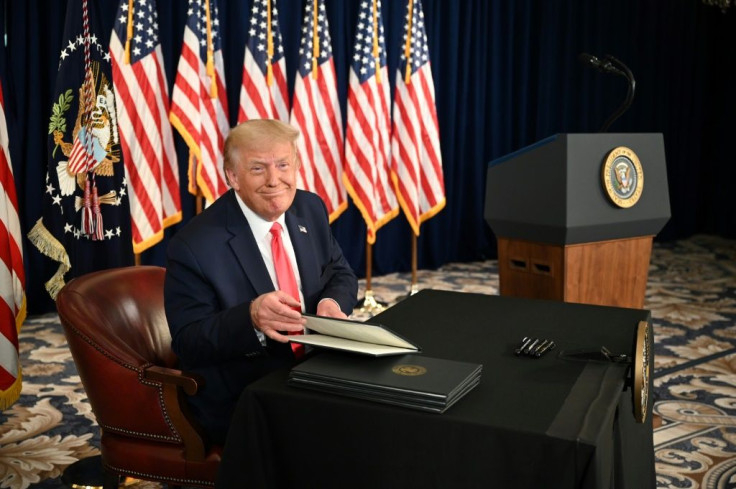Payroll Tax, Evictions, And Other Things To Know About President Trump's Executive Orders
KEY POINTS
- President Trump's executive orders addressed unemployment benefits, payroll tax, evictions, and student loans
- The orders have been criticized for murky language and are expected to face legal backlash for attempting to circumvent Congress
- The orders did not address the end of the Paycheck Protection Program and another possible stimulus check
President Trump tried to promote the appearance of hope about his executive orders over the weekend, but questions continue to circle the effectiveness and legality of his attempt to circumvent Congress on another coronavirus relief package. The language used has already created confusion on Capitol Hill and in the media over the orders and their proposed intentions.
“If you read what he signed, it is not what he says it was,” John King said on CNN. “You cannot fool people about an unemployment check. They either get it or they don't.”
Analysts have done their best to determine the effects of the executive orders, should they get past any legal challenges, and this is what they determined.
Unemployment Benefits
One of the most publicized aspects of the executive orders was expanding unemployment benefits to provide an additional $400 a week. This is a drop from the $600 extra a week originally provided by the CARES Act.
However, the action is found to be loaded with caveats that could mean some may not see any additional unemployment aid.
The first asterisk was that actual federal relief only accounts for 75% of the proposed relief payment and the states would have to provide the other 25%. This equates to $300 in federal aid and $100 from state unemployment benefits. Unfortunately, some of those hit hardest during the pandemic may not see anything from it if states can’t or won’t raise their benefits.
Then there’s the issue of states distributing the aid through their unemployment systems, many of which have been pushed to their breaking point during the pandemic. In most cases, states would have to set up a new system of distribution to ensure aid gets out properly.
“The state has to enter an agreement saying not only can they pay the benefit, but that they have some ability to administer the benefit,” National Employment Law Project’s Michelle Evermore told CNN.
Payroll Tax
Despite what Trump touted about the temporary change to payroll taxes, his weekend order equates to a deferral to Dec. 31 and not an actual cut. This is similar to the action taken by the U.S. Treasury Department during the first days of the coronavirus pandemic, when it pushed from April 15 to July 15.
It’s this order that stands to face the harshest legal challenge because changing tax laws is typically reserved for Congress. The idea has also been widely rejected by members on both sides of the aisle because it does not help the unemployed and could place further strain on Social Security and Medicare, though Trump has insisted it won’t.
There are also questions of how employers will proceed given the current lack of an outline. Employers may wish to continue withholding taxes or stop withholding during the period, which would mean employees could potentially owe money down the road.
Evictions
Some of the murkiest language used in Trump’s executive orders surrounds evictions that could potentially be awaiting residents after the moratorium lapsed in July. Instead, the order says any potential measures to aid renters will be “considered” by the Center for Disease Control and Prevention and Department of Health and Human Services.
The only other aid possibly awaiting renters would be federal funds the Housing and Urban Development and Treasury secretaries can use to help struggling renters.
However, a timetable was not provided in the order and it was not clear how long this process could end up taking.
Student Loans
The one order taken signed by Trump expected to go largely unopposed is extending student loan relief another three months.
March’s CARES Act put all federal student loans on forbearance through Sept. 30 with no mounting interest. Trump’s order would effectively push the forbearance expiration date to Dec. 31, though the Department of Education did not say how it would implement the forbearance extension.
What Wasn’t Said
One the biggest omission from this weekend’s executive order was another potential stimulus check in the vain of the $1,200 relief check provided under the CARES Act.
From one perspective, the payroll tax order serves as the means to compensate for the lack of a check. However, it is only applicable to those currently employed and provides no additional aid to those who remain unemployed or furloughed because of the coronavirus pandemic.
Another concern is the end of the Paycheck Protection Program meant to help small businesses struggling through the pandemic. The program was rife with problems and reports of attempted fraud, but it provided billions of dollars so businesses could remain open and keep employees on payroll. The program hit its end-date on Saturday and Trump did not comment about the program’s future.

© Copyright IBTimes 2024. All rights reserved.





















